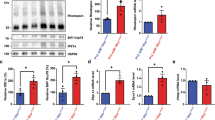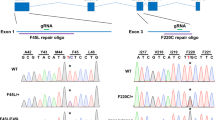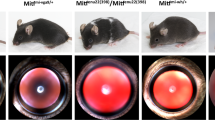Abstract
Mutations in Rpe65 disrupt synthesis of the opsin chromophore ligand 11-cis-retinal and cause Leber congenital amaurosis (LCA), a severe, early-onset retinal dystrophy. To test whether light-independent signaling by unliganded opsin causes the degeneration, we used Rpe65-null mice, a model of LCA. Dark-adapted Rpe65−/− mice behaved as if light adapted, exhibiting reduced circulating current, accelerated response turn-off, and diminished intracellular calcium. A genetic block of transducin signaling completely rescued degeneration irrespective of an elevated level of retinyl ester. These studies clearly show that activation of sensory transduction by unliganded opsin, and not the accumulation of retinyl esters, causes light-independent retinal degeneration in LCA. A similar mechanism may also be responsible for degeneration induced by vitamin A deprivation.
This is a preview of subscription content, access via your institution
Access options
Subscribe to this journal
Receive 12 print issues and online access
$209.00 per year
only $17.42 per issue
Buy this article
- Purchase on Springer Link
- Instant access to full article PDF
Prices may be subject to local taxes which are calculated during checkout







Similar content being viewed by others
References
Morimura, H. et al. Mutations in the RPE65 gene in patients with autosomal recessive retinitis pigmentosa or Leber congenital amaurosis. Proc. Natl. Acad. Sci. USA 95, 3088–3093 (1998).
Gu, S.M. et al. Mutations in RPE65 cause autosomal recessive childhood-onset severe retinal dystrophy. Nat. Genet. 17, 194–197 (1997).
Marlhens, F. et al. Mutations in RPE65 cause Leber's congenital amaurosis. Nat. Genet. 17, 139–141 (1997).
Felius, J. et al. Clinical course and visual function in a family with mutations in the RPE65 gene. Arch. Ophthalmol. 120, 55–61 (2002).
Lorenz, B. et al. Early-onset severe rod-cone dystrophy in young children with RPE65 mutations. Invest. Ophthalmol. Vis. Sci. 41, 2735–2742 (2000).
Redmond, T.M. et al. Rpe65 is necessary for production of 11-cis-vitamin A in the retinal visual cycle. Nat. Genet. 20, 344–351 (1998).
Seeliger, M.W. et al. New views on RPE65 deficiency: the rod system is the source of vision in a mouse model of Leber congenital amaurosis. Nat. Genet. 29, 70–74 (2001).
Ablonczy, Z. et al. 11-cis-retinal reduces constitutive opsin phosphorylation and improves quantum catch in retinoid-deficient mouse rod photoreceptors. J. Biol. Chem. 277, 40491–40498 (2002).
Rohrer, B. et al. Correlation of regenerable opsin with rod ERG signal in Rpe65−/− mice during development and aging. Invest. Ophthalmol. Vis. Sci. 44, 310–315 (2003).
Van Hooser, J.P. et al. Rapid restoration of visual pigment and function with oral retinoid in a mouse model of childhood blindness. Proc. Natl. Acad. Sci. USA 97, 8623–8628 (2000).
Van Hooser, J.P. et al. Recovery of visual functions in a mouse model of Leber congenital amaurosis. J. Biol. Chem. 277, 19173–19182 (2002).
Surya, A. & Knox, B. Modulation of opsin apoprotein activity by retinal. Dark activity of rhodopsin formed at low temperature. J. Biol. Chem. 272, 21745–21750 (1997).
Cornwall, M.C. & Fain, G.L. Bleached pigment activates transduction in isolated rods of the salamander retina. J. Physiol. 480, 261–279 (1994).
Cornwall, M.C., Matthews, H.R., Crouch, R.K. & Fain, G.L. Bleached pigment activates transduction in salamander cones. J. Gen. Physiol. 106, 543–557 (1995).
Melia, T.J., Jr., Cowan, C.W., Angleson, J.K. & Wensel, T.G. A comparison of the efficiency of G protein activation by ligand-free and light-activated forms of rhodopsin. Biophys. J. 73, 3182–3191 (1997).
Fain, G.L. & Lisman, J.E. Photoreceptor degeneration in vitamin A deprivation and retinitis pigmentosa: the equivalent light hypothesis. Exp. Eye Res. 57, 335–340 (1993).
Fain, G.L. & Lisman, J.E. Light, Ca2+, and photoreceptor death: new evidence for the equivalent-light hypothesis from arrestin knockout mice. Invest. Ophthalmol. Vis. Sci. 40, 2770–2772 (1999).
Jin, S., Cornwall, M.C. & Oprian, D.D. Opsin activation as a cause of congenital night blindness. Nat. Neurosci. 6, 731–735 (2003).
Hao, W. et al. Evidence for two apoptotic pathways in light-induced retinal degeneration. Nat. Genet. 32, 254–260 (2002).
Baylor, D.A., Lamb, T.D. & Yau, K.W. The membrane current of single rod outer segments. J. Physiol. 288, 589–611 (1979).
Beavo, J.A. et al. Effects of xanthine derivatives on lipolysis and on adenosine 3′,5′- monophosphate phosphodiesterase activity. Mol. Pharmacol. 6, 597–603 (1970).
Cervetto, L. & McNaughton, P.A. The effects of phosphodiesterase inhibitors and lanthanum ions on the light-sensitive current of toad retinal rods. J. Physiol. 370, 91–109 (1986).
Cornwall, M.C., Fein, A. & MacNichol, E.F., Jr. Cellular mechanisms that underlie bleaching and background adaptation. J. Gen. Physiol. 96, 345–372 (1990).
Fain, G.L., Matthews, H.R., Cornwall, M.C. & Koutalos, Y. Adaptation in vertebrate photoreceptors. Physiol. Rev. 81, 117–151 (2001).
Chen, C.K. et al. Slowed recovery of rod photoresponse in mice lacking the GTPase accelerating protein RGS9-1. Nature 403, 557–560 (2000).
Calvert, P.D. et al. Phototransduction in transgenic mice after targeted deletion of the rod transducin α-subunit. Proc. Natl. Acad. Sci. USA 97, 13913–13918 (2000).
Sampath, A.P., Matthews, H.R., Cornwall, M.C. & Fain, G.L. Bleached pigment produces a maintained decrease in outer segment Ca2+ in salamander rods. J. Gen. Physiol. 111, 53–64 (1998).
Woodruff, M.L. et al. Measurement of cytoplasmic calcium concentration in the rods of wild-type and transducin knock-out mice. J. Physiol. 542, 843–854 (2002).
Franklin, J.L., Sanz-Rodriguez, C., Juhasz, A., Deckwerth, T.L. & Johnson, E.M. Jr. Chronic depolarization prevents programmed death of sympathetic neurons in vitro but does not support growth: requirement for Ca2+ influx but not Trk activation. J. Neurosci. 15, 643–664 (1995).
Sampath, A.P., Matthews, H.R., Cornwall, M.C., Bandarchi, J. & Fain, G.L. Light-dependent changes in outer segment free-Ca2+ concentration in salamander cone photoreceptors. J. Gen. Physiol. 113, 267–277 (1999).
Matthews, H.R. & Fain, G.L. The effect of light on outer segment calcium in salamander rods. J. Physiol. (in the press).
Sokolov, M. et al. Massive light-driven translocation of transducin between the two major compartments of rod cells: a novel mechanism of light adaptation. Neuron 33, 95–106 (2002).
Mendez, A., Lem, J., Simon, M. & Chen, J. Light-dependent translocation of arrestin in the absence of rhodopsin phosphorylation and transducin signaling. J. Neurosci. 23, 3124–3129 (2003).
Dowling, J.E. & Wald, G. Vitamin A deficiency and night blindness. Proc. Natl. Acad. Sci. USA 44, 648–661 (1958).
Dowling, J.E. & Wald, G. The biological activity of vitamin A acid. Proc. Natl. Acad. Sci. USA 46, 587–608 (1960).
Dartnall, H.J.A. Photosensitivity. in Handbook of Sensory Physiology vol. VII/1 (ed. Dartnall, H.J.A.) 122–145 (Springer, Berlin, 1972).
Jones, G.J., Fein, A., MacNichol, E.F., Jr., & Cornwall, M.C. Visual pigment bleaching in isolated salamander retinal cones. Microspectrophotometry and light adaptation. J. Gen. Physiol. 102, 483–502 (1993).
Tang, G., Dolnikowski, G.G., Blanco, M.C., Fox, J.G. & Russel, R.M. Serum carotenoids and retinoids in ferrets fed canthaxanthin. J. Nutr. Biochem. 4, 58–63 (1993).
Garwin, G.G. & Saari, J.C. High-performance liquid chromatography analysis of visual cycle retinoids. Meth. Enzymol. 316, 313–324 (2000).
Carter-Dawson, L. et al. Rhodopsin, 11-cis vitamin A, and interstitial retinol-binding protein (IRBP) during retinal development in normal and rd mutant mice. Dev. Biol. 116, 431–438 (1986).
Palczewski, K. et al. Kinetics of visual pigment regeneration in excised mouse eyes and in mice with a targeted disruption of the gene encoding interphotoreceptor retinol-binding protein or arrestin. Biochemistry 38, 12012–12019 (1999).
Matthews, H.R. & Fain, G.L. Time course and magnitude of the calcium release induced by bright light in salamander rods. J. Physiol. 542, 829–841 (2002).
Grynkiewicz, G., Poenie, M. & Tsien, R.Y. A new generation of Ca2+ indicators with greatly improved fluorescence properties. J. Biol. Chem. 260, 3440–3450 (1985).
Acknowledgements
We thank M. Cilluffo for help with animal care, M. Fain for drawing Fig. 1, F. Celestin for assistance with histological sections, M. C. Cornwall and H. R. Matthews for assistance with early experiments and M. S. Obin for discussion and comments. Support for this research was provided by the US National Institutes of Health (to G.L.F., J.L. and Z.W.; Core Grants for Vision Research to the Jules Stein Eye Institute and Tufts Center for Vision Research) and the Massachusetts Lions Eye Research Fund (an institutional grant to the Department of Ophthalmology, New England Medical Center).
Author information
Authors and Affiliations
Corresponding author
Ethics declarations
Competing interests
The authors declare no competing financial interests.
Supplementary information
Rights and permissions
About this article
Cite this article
Woodruff, M., Wang, Z., Chung, H. et al. Spontaneous activity of opsin apoprotein is a cause of Leber congenital amaurosis. Nat Genet 35, 158–164 (2003). https://doi.org/10.1038/ng1246
Received:
Accepted:
Published:
Issue Date:
DOI: https://doi.org/10.1038/ng1246
This article is cited by
-
Fundus autofluorescence and ellipsoid zone (EZ) line width can be an outcome measurement in RHO-associated autosomal dominant retinitis pigmentosa
Graefe's Archive for Clinical and Experimental Ophthalmology (2019)
-
Mg2+/Ca2+ cation binding cycle of guanylyl cyclase activating proteins (GCAPs): role in regulation of photoreceptor guanylyl cyclase
Molecular and Cellular Biochemistry (2010)
-
Haploinsufficiency of RanBP2 is neuroprotective against light-elicited and age-dependent degeneration of photoreceptor neurons
Cell Death & Differentiation (2009)
-
A moving story of receptors
Nature (2008)
-
Triggering of Bcl-2-related pathway is associated with apoptosis of photoreceptors in Rpe65 −/− mouse model of Leber’s Congenital Amaurosis
Apoptosis (2008)



